Volcanic Activity Classification Through Semi-Supervised Learning Applied to Satellite Radiance Time Series
Abstract
1. Introduction
2. Materials and Methods
2.1. Dataset
2.2. Case Studies
2.3. General Architecture of an SGAN Model
2.4. The SGAN Model for the Assessment of the Volcanic Activity
- ‘clear sky’ (class 0) for pixels that show no cloudy prototype signature and no hot spot presence;
- ‘cloud-contaminated’ (class 1) for pixels that are affected by the cloudy signature;
- ‘thermal anomaly’ (class 2) for pixels that are identified as hot spot;
- ‘ash-contaminated’ (class 3) for pixels characterized by the presence of volcanic ash.
2.5. Performance Evaluation and Validation
3. Results
3.1. Etna
3.1.1. The July 2006 Subterminal Eruption
3.1.2. The 2008–2009 Flank Eruption
3.1.3. The February 2021 Lava Fountain
3.2. Stromboli
3.3. Tajogaite
3.4. Nyiragongo
3.5. Performance Evaluation
4. Discussion
- the early effusive phase, characterized by the emission of a huge ash plume associated with a lava fountain from the northern part of the eruptive fissure (on 13 May), and the initial increase in the thermal activity;
- the waning phase, with a decrease in the thermal activity, which continued until 7 June, consistently with the low intensity of volcanic activity revealed by field observations during the same period;
- the beginning of the rising phase, which lasted until 27 July, and was characterized by alternating periods of high thermal activity and ash emission during the Strombolian activity, which led to highly variable viewing conditions.
5. Conclusions
Author Contributions
Funding
Data Availability Statement
Acknowledgments
Conflicts of Interest
References
- Spark, R.S.J.; Aspinal, W.P. Volcanic Activity: Frontiers and challenges in forecasting, prediction and risk assessment. State Planet Front. Chall. Geophys. 2004, 19, 359–373. [Google Scholar]
- Sparks, R.S.J. Forecasting volcanic eruptions. Earth Planet. Sci. Lett. 2003, 210, 1–15. [Google Scholar] [CrossRef]
- Brown, S.K.; Loughlin, S.C.; Sparks, R.S.J.; Vye-Brown, C.; Barclay, J.; Calder, E.; Cottrell, E.; Jolly, G.; Komorowski, J.-C.; Mandeville, C.; et al. Global Volcanic Hazard and Risk; Cambridge University Press: Cambridge, UK, 2015; Volume 1, pp. 81–172. [Google Scholar]
- Chien, S.A.; Davies, A.G.; Doubleday, J.; Tran, D.Q.; Mclaren, D.; Chi, W.; Maillard, A. Automated volcano monitoring using multiple space and ground sensors. J. Aerosp. Inf. Syst. 2020, 17, 214–228. [Google Scholar] [CrossRef]
- Beker, T.; Ansari, H.; Montazeri, S.; Song, Q.; Zhu, X.X. Deep learning for subtle volcanic deformation detection with InSAR data in central volcanic zone. IEEE Trans. Geosci. Remote Sens. 2023, 61, 5218520. [Google Scholar] [CrossRef]
- Korolev, S.; Urmanov, I.; Sorokin, A.; Girina, O. Detecting Volcano Thermal Activity in Night Images Using Machine Learning and Computer Vision. Remote Sens. 2023, 15, 4815. [Google Scholar] [CrossRef]
- Punia, S.K.; Kumar, M.; Stephan, T.; Deverajan, G.G.; Patan, R. Performance analysis of machine learning algorithms for big data classification: Ml and ai-based algorithms for big data analysis. Int. J. E-Health Med. Commun. (IJEHMC) 2023, 12, 60–75. [Google Scholar] [CrossRef]
- Tilling, R.I. Volcanic hazards and their mitigation: Progress and problems. Rev. Geophys. 1989, 27, 237–269. [Google Scholar] [CrossRef]
- Munappy, A.; Bosch, J.; Olsson, H.H.; Arpteg, A.; Brinne, B. Data management challenges for deep learning. In Proceedings of the 2019 45th Euromicro Conference on Software Engineering and Advanced Applications (SEAA), Kallithea, Greece, 28–30 August 2019. [Google Scholar]
- Zhou, L.; Pan, S.; Wang, J.; Vasilakos, A.V. Machine learning on big data: Opportunities and challenges. Neurocomputing 2019, 237, 350–361. [Google Scholar] [CrossRef]
- Khalid, S.; Khalil, T.; Nasreen, S. A survey of feature selection and feature extraction techniques in machine learning. In Proceedings of the 2014 Science and Information Conference, London, UK, 27–29 August 2014. [Google Scholar]
- Dara, S.; Tumma, P. Feature extraction by using deep learning: A survey. In Proceedings of the 2018 Second International Conference on Electronics, Communication and Aerospace Technology (ICECA), Coimbatore, India, 29–31 March 2018. [Google Scholar]
- Valade, S.; Ley, A.; Massimetti, F.; D’Hondt, O.; Laiolo, M.; Coppola, D.; Loibl, D.; Hellwich, O.; Walter, T.R. Towards Global Volcano Monitoring Using Multisensor Sentinel Missions and Artificial Intelligence: The MOUNTS Monitoring System. Remote Sens. 2019, 11, 1528. [Google Scholar] [CrossRef]
- Guzman, S.; Carniel, R. Chapter Machine Learning in Volcanology: A Review. In Updates in Volcanology—Transdisciplinary Nature of Volcano Science; Németh, K., Ed.; IntechOpen: London, UK, 2021; pp. 1–26. [Google Scholar]
- Giudicepietro, F.; Calvari, S.; Alparone, S.; Bianco, F.; Bonaccorso, A.; Bruno, V.; Caputo, T.; Cristaldi, A.; D’Auria, L.; De Cesare, W.; et al. Integration of Ground-Based Remote-Sensing and In Situ Multidisciplinary Monitoring Data to Analyze the Eruptive Activity of Stromboli Volcano in 2017–2018. Remote Sens. 2019, 11, 1813. [Google Scholar] [CrossRef]
- Manley, G.F.; Mather, T.A.; Pyle, D.M.; Clifton, D.A.; Rodgers, M.; Thompson, G.; Londono, J.M. A deep active learning approach to the automatic classification of volcano-seismic events. Front. Earth Sci. 2022, 10, 807926. [Google Scholar] [CrossRef]
- Pignatelli, A.; Piochi, M. Machine learning applied to rock geochemistry for predictive outcomes: The Neapolitan volcanic history case. J. Volcanol. Geotherm. Res. 2021, 415, 107254. [Google Scholar] [CrossRef]
- Cabrera, L.; Ardid, A.; Melchor, I.; Ruiz, S.; Symmes-Lopetegui, B.; Carlos Báez, J.; Cronin, S. Eruption forecasting model for Copahue volcano (southern Andes) using seismic data and machine learning: A joint interpretation with geodetic data (GNSS and InSAR). Seismol. Res. Lett. 2024, 95, 2595–2610. [Google Scholar] [CrossRef]
- Dye, B.C.; Morra, G. Machine learning as a detection method of Strombolian eruptions in infrared images from Mount Erebus, Antarctica. Phys. Earth Planet. Inter. 2020, 305, 106508. [Google Scholar] [CrossRef]
- Witsil, A.J.; Johnson, J.B. Volcano video data characterized and classified using computer vision and machine learning algorithms. Geosci. Front. 2020, 11, 1789–1803. [Google Scholar] [CrossRef]
- Sun, J.; Wauthier, C.; Stephens, K.; Gervais, M.; Cervone, G.; La Femina, P.; Higgins, M. Automatic detection of volcanic surface deformation using deep learning. J. Geophys. Res. Solid Earth 2020, 125, e2020JB019840. [Google Scholar] [CrossRef]
- Fedkin, N.M.; Li, C.; Krotkov, N.A.; Hedelt, P.; Loyola, D.G.; Dickerson, R.R.; Spurr, R. Volcanic SO2 effective layer height retrieval for the Ozone Monitoring Instrument (OMI) using a machine-learning approach. Atmos. Meas. Tech. 2021, 14, 3673–3691. [Google Scholar] [CrossRef]
- Romeo, F.; Mereu, L.; Scollo, S.; Papa, M.; Corradini, S.; Merucci, L.; Marzano, F.S. Volcanic Cloud Detection and Retrieval Using Satellite Multisensor Observations. Remote Sens. 2023, 15, 888. [Google Scholar] [CrossRef]
- Saunders-Shultz, P. Deep Learning Detection and Quantification of Volcanic Thermal Signals in Infrared Satellite Data. Master’s Thesis, University of Alaska Fairbanks, Fairbanks, AK, USA, 2024. [Google Scholar]
- Usama, M.; Qadir, J.; Raza, A.; Arif, H.; Yau, K.L.A.; Elkhatib, Y.; Al-Fuqaha, A. Unsupervised machine learning for networking: Techniques, applications and research challenges. IEEE Access 2019, 7, 65579–65615. [Google Scholar] [CrossRef]
- Gupta, S.; Gupta, A. Dealing with noise problem in machine learning data-sets: A systematic review. Procedia Comput. Sci. 2019, 161, 466–474. [Google Scholar] [CrossRef]
- Nasteski, V. An overview of the supervised machine learning methods. Horizons 2017, 4, 56. [Google Scholar] [CrossRef]
- Zhu, X.; Goldberg, A.B. Introduction to Semi-Supervised Learning; Springer Nature: Cham, Switzerland, 2022. [Google Scholar]
- Odena, A. Semi-Supervised Learning with Generative Adversarial Networks. arXiv 2016, arXiv:1606.01583. [Google Scholar]
- Kerkmann, J.; Lutz, H.J.; König, M.; Prieto, J.; Pylkko, P.; Roesli, H.P.; Rosenfeld, D.; Zwatz-Meise, V.; Schmetz, J.; Schipper, J.; et al. MSG Channels, Interpretation Guide, Weather, Surface Conditions and Atmospheric Constituents. 2004. Available online: https://rammb.cira.colostate.edu/wmovl/vrl/pptlectures/eumetsat/index.html (accessed on 7 May 2025).
- Wooster, M.J.; Roberts, G.; Freeborn, P.H.; Xu, W.; Govaerts, Y.; Beeby, R.; He, J.; Lattanzio, A.; Fisher, D.; Mullen, R. LSA SAF Meteosat FRP products–Part 1: Algorithms, product contents, and analysis. Atmos. Chem. Phys. 2015, 15, 13217–13239. [Google Scholar] [CrossRef]
- Debaecker, V.; Kocaman, S.; Saunier, S.; Garcia, K.; Bas, S.; Just, D. On the geometric accuracy and stability of MSG SEVIRI images. Atmos. Environ. 2021, 262, 118645. [Google Scholar] [CrossRef]
- Marchese, F.; Falconieri, A.; Filizzola, C.; Pergola, N.; Tramutoli, V. Investigating Volcanic Plumes from Mt. Etna Eruptions of December 2015 by Means of AVHRR and SEVIRI Data. Sensors 2019, 19, 1174. [Google Scholar] [CrossRef] [PubMed]
- Alonso, C.; Durão, R.; Gouveia, C.M. A Year of Volcanic Hot-Spot Detection over Mediterranean Europe Using SEVIRI/MSG. Remote Sens. 2023, 15, 5219. [Google Scholar] [CrossRef]
- Ganci, G.; Cappello, A.; Zago, V.; Bilotta, G.; Herault, A.; Del Negro, C. 3D Lava flow mapping of the 17–25 May 2016 Etna eruption using tri-stereo optical satellite data. Ann. Geophys. 2019, 62, VO220. [Google Scholar] [CrossRef]
- Del Negro, C.; Cappello, A.; Neri, M.; Bilotta, G.; Hérault, A.; Ganci, G. Lava flow hazards at Mount Etna: Constraints imposed by eruptive history and numerical simulations. Sci. Rep. 2013, 3, 3493. [Google Scholar]
- Gieske, A.S.M.; Hendrikse, J.H.M.; Retsios, V.; Van Leeuwen, B.; Maathuis, B.H.P.; Albentosa, M.R.; Sobrino, J.A.; Timmermans, W.J.; Su, Z. Processing of MSG-1 SEVIRI Data in the Thermal Infrared-Algorithm Development with the Use of the SPARC2004 Data Set. In Proceedings of the ESA WPP-250 SPARC Final Workshop, Enschede, The Netherlands, 4–5 July 2005. [Google Scholar]
- Zuccarello, F.; Bilotta, G.; Ganci, G.; Proietti, C.; Cappello, A. Assessing impending hazards from summit eruptions: The new probabilistic map for lava flow inundation at Mt. Etna. Sci. Rep. 2023, 13, 19543. [Google Scholar] [CrossRef]
- Del Negro, C.; Cappello, A.; Ganci, G. Quantifying lava flow hazards in response to effusive eruption. Bulletin 2016, 128, 752–763. [Google Scholar] [CrossRef]
- Ganci, G.; Vicari, A.; Cappello, A.; Del Negro, C. An emergent strategy for volcano hazard assessment: From thermal satellite monitoring to lava flow modeling. Remote Sens. Environ. 2012, 119, 197–207. [Google Scholar] [CrossRef]
- Rosi, M.; Bertagnini, A.; Landi, P. Onset of the persistent activity at Stromboli volcano (Italy). Bull. Volcanol. 2000, 62, 294–300. [Google Scholar] [CrossRef]
- Mattia, M.; Di Lieto, B.; Ganci, G.; Bruno, V.; Romano, P.; Ciancitto, F.; De Martino, P.; Gambino, S.; Aloisi, M.; Sciotto, M. The 2019 Eruptive Activity at Stromboli Volcano: A Multidisciplinary Approach to Reveal Hidden Features of the “Unexpected” 3 July Paroxysm. Remote Sens. 2021, 13, 4064. [Google Scholar] [CrossRef]
- Civico, R.; Ricci, T.; Scarlato, P.; Taddeucci, J.; Andronico, D.; Del Bello, E.; Pérez, N.M. High-resolution digital surface model of the 2021 eruption deposit of Cumbre Vieja volcano, La Palma, Spain. Sci. Data 2022, 9, 435. [Google Scholar] [CrossRef] [PubMed]
- Sicard, M.; Córdoba-Jabonero, C.; Barreto, A.; Welton, E.J.; Gil-Díaz, C.; Carvajal-Pérez, C.V.; Comerón, A.; García, O.; García, R.; López-Cayuela, M.-Á. Volcanic Eruption of Cumbre Vieja, La Palma, Spain: A First Insight to the Particulate Matter Injected in the Troposphere. Remote Sens. 2022, 14, 2470. [Google Scholar] [CrossRef]
- Day, S.J.; Carracedo, J.C.; Guillou, H.; Gravestock, P. Recent structural evolution of the Cumbre Vieja volcano, La Palma, Canary Islands: Volcanic rift zone reconfiguration as a precursor to volcano flank instability? J. Volcanol. Geotherm. Res. 1999, 94, 135–167. [Google Scholar] [CrossRef]
- Hamaguchi, H.; Nishimura, T.; Zana, N. Process of the 1977 Nyiragongo eruption inferred from the analysis of long-period earthquakes and volcanic tremors. Tectonophysics 1992, 209, 241–254. [Google Scholar] [CrossRef]
- Tedesco, D.; Vaselli, O.; Papale, P.; Carn, S.A.; Voltaggio, M.; Sawyer, G.M.; Tassi, F. January 2002 volcano-tectonic eruption of Nyiragongo volcano, Democratic Republic of Congo. J. Geophys. Res. Solid Earth 2007, 112, B09202. [Google Scholar] [CrossRef]
- Boudoire, G.; Calabrese, S.; Colacicco, A.; Sordini, P.; Macumu, P.H.; Rafflin, V.; Valade, S.; Mweze, T.; Mwepu, J.-C.K.; Habari, F.S.; et al. Scientific response to the 2021 eruption of Nyiragongo based on the implementation of a participatory monitoring system. Sci. Rep. 2022, 12, 7488. [Google Scholar] [CrossRef]
- Goodfellow, I.; Pouget-Abadie, J.; Mirza, M.; Xu, B.; Warde-Farley, D.; Ozair, S.; Bengio, Y. Generative adversarial networks. Commun. ACM 2020, 63, 139–144. [Google Scholar] [CrossRef]
- Métrich, N.; Bertagnini, A.; Pistolesi, M. Paroxysms at Stromboli volcano (Italy): Source, genesis and dynamics. Front. Earth Sci. 2021, 9, 593339. [Google Scholar] [CrossRef]
- INGV-OE Bulletin. Available online: https://www.ct.ingv.it/index.php/monitoraggio-e-sorveglianza/prodotti-del-monitoraggio/bollettini-settimanali-multidisciplinari (accessed on 17 December 2024).
- Andronico, D.; Spinetti, C.; Cristaldi, A.; Buongiorno, M.F. Observations of Mt. Etna volcanic ash plumes in 2006: An integrated approach from ground-based and polar satellite NOAA–AVHRR monitoring system. J. Volcanol. Geotherm. Res. 2009, 180, 135–147. [Google Scholar] [CrossRef]
- Neri, M.; Behncke, B.; Burton, M.; Galli, G.; Giammanco, S.; Pecora, E.; Reitano, D. Continuous soil radon monitoring during the July 2006 Etna eruption. Geophys. Res. Lett. 2006, 33, L24316. [Google Scholar] [CrossRef]
- Ganci, G.; Bilotta, G.; Zuccarello, F.; Calvari, S.; Cappello, A. A Multi-Sensor Satellite Approach to Characterize the Volcanic Deposits Emitted during Etna’s Lava Fountaining: The 2020–2022 Study Case. Remote Sens. 2023, 15, 916. [Google Scholar] [CrossRef]
- Romero, J.E.; Burton, M.; Cáceres, F.; Taddeucci, J.; Civico, R.; Ricci, T.; Perez, N.M. The initial phase of the 2021 Cumbre Vieja ridge eruption (Canary Islands): Products and dynamics controlling edifice growth and collapse. J. Volcanol. Geotherm. Res. 2022, 431, 107642. [Google Scholar] [CrossRef]
- Biass, S.; Reyes-Hardy, M.P.; Gregg, C.; Di Maio, L.S.; Dominguez, L.; Frischknecht, C.; Perez, N. The spatiotemporal evolution of compound impacts from lava flow and tephra fallout on buildings: Lessons from the 2021 Tajogaite eruption (La Palma, Spain). Bull. Volcanol. 2024, 86, 10. [Google Scholar] [CrossRef] [PubMed]
- Coppola, D.; Laiolo, M.; Cigolini, C.; Massimetti, F.; Delle Donne, D.; Ripepe, M.; Arias, H.; Barsotti, S.; Parra, C.B.; Centeno, R.G.; et al. Thermal Remote Sensing for Global Volcano Monitoring: Experiences from the MIROVA System. Front. Earth Sci. 2020, 7, 362. [Google Scholar] [CrossRef]
- Wright, R.; Flynn, L.P.; Garbeil, H.; Harris, A.J.L.; Pilger, E. MODVOLC: Near-real-time thermal monitoring of global volcanism. J. Volcanol. Geotherm. Res. 2004, 135, 29–49. [Google Scholar] [CrossRef]
- Prata, F.; Lynch, M. Passive Earth Observations of Volcanic Clouds in the Atmosphere. Atmosphere 2019, 10, 199. [Google Scholar] [CrossRef]
- Wooster, M.J.; Roberts, G.; Perry, G.L.W.; Kaufman, Y.J. Retrieval of biomass combustion rates and totals from fire radiative power observations: FRP derivation and calibration relationships between biomass consumption and fire radiative energy release. J. Geophys. Res. Atmos. 2005, 110, D24311. [Google Scholar] [CrossRef]
- Ganci, G.; Bilotta, G.; Zuccarello, F.; Cappello, A. Opportunities Offered by the MTG Flexible Combined Imager for Volcano Monitoring. In Proceedings of the IGARSS 2023—2023 IEEE International Geoscience and Remote Sensing Symposium, Pasadena, CA, USA, 16–21 July 2023; pp. 4746–4747. [Google Scholar]

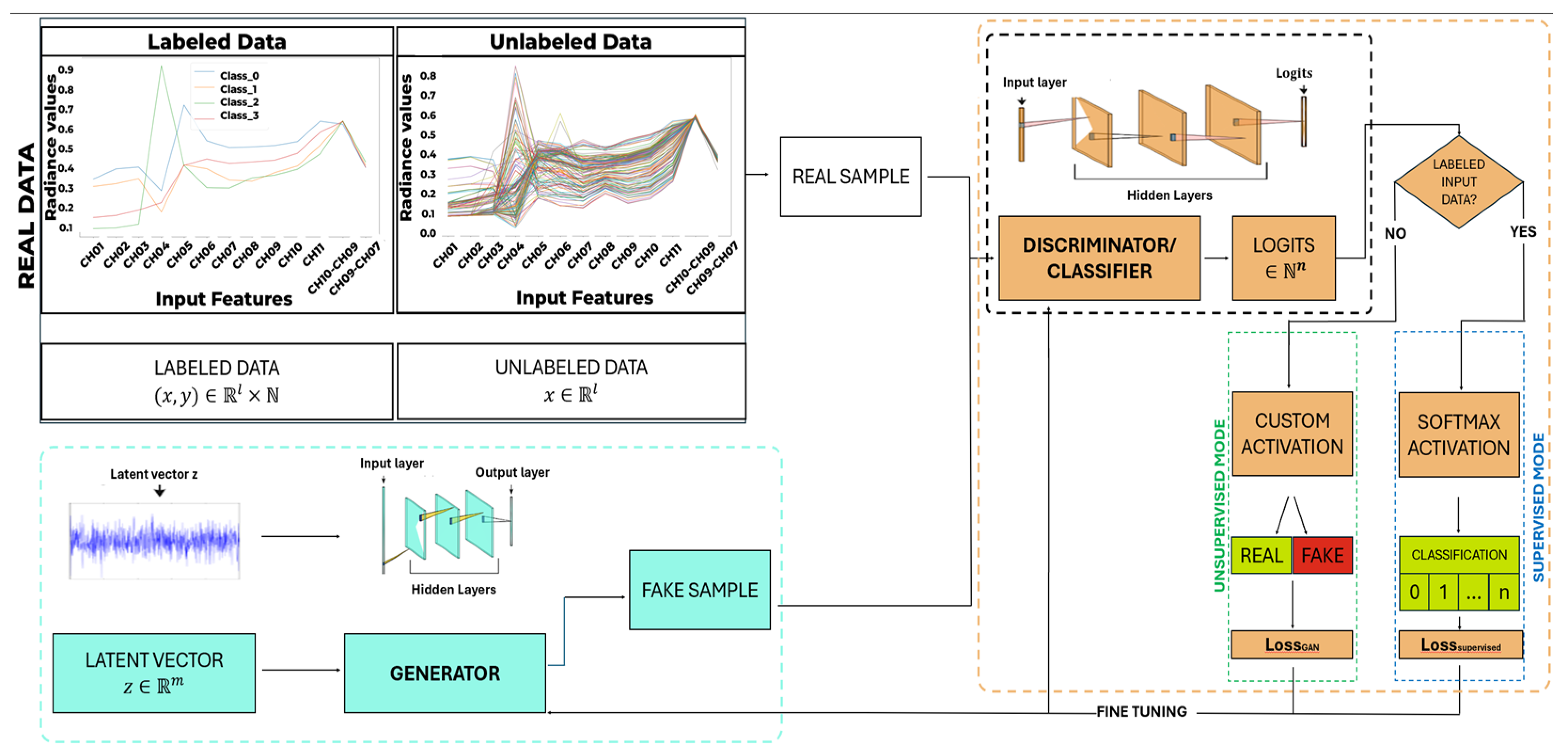

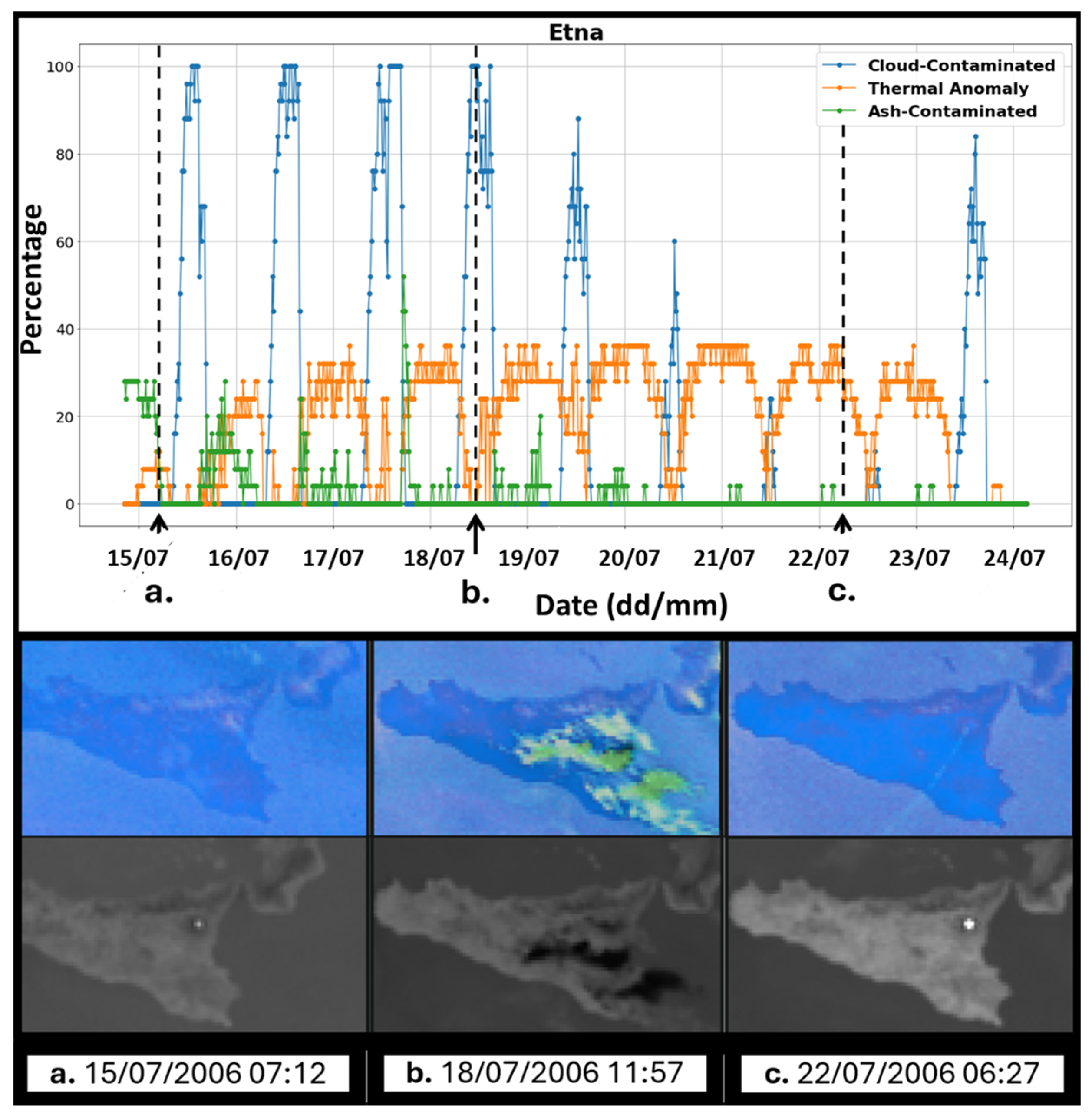
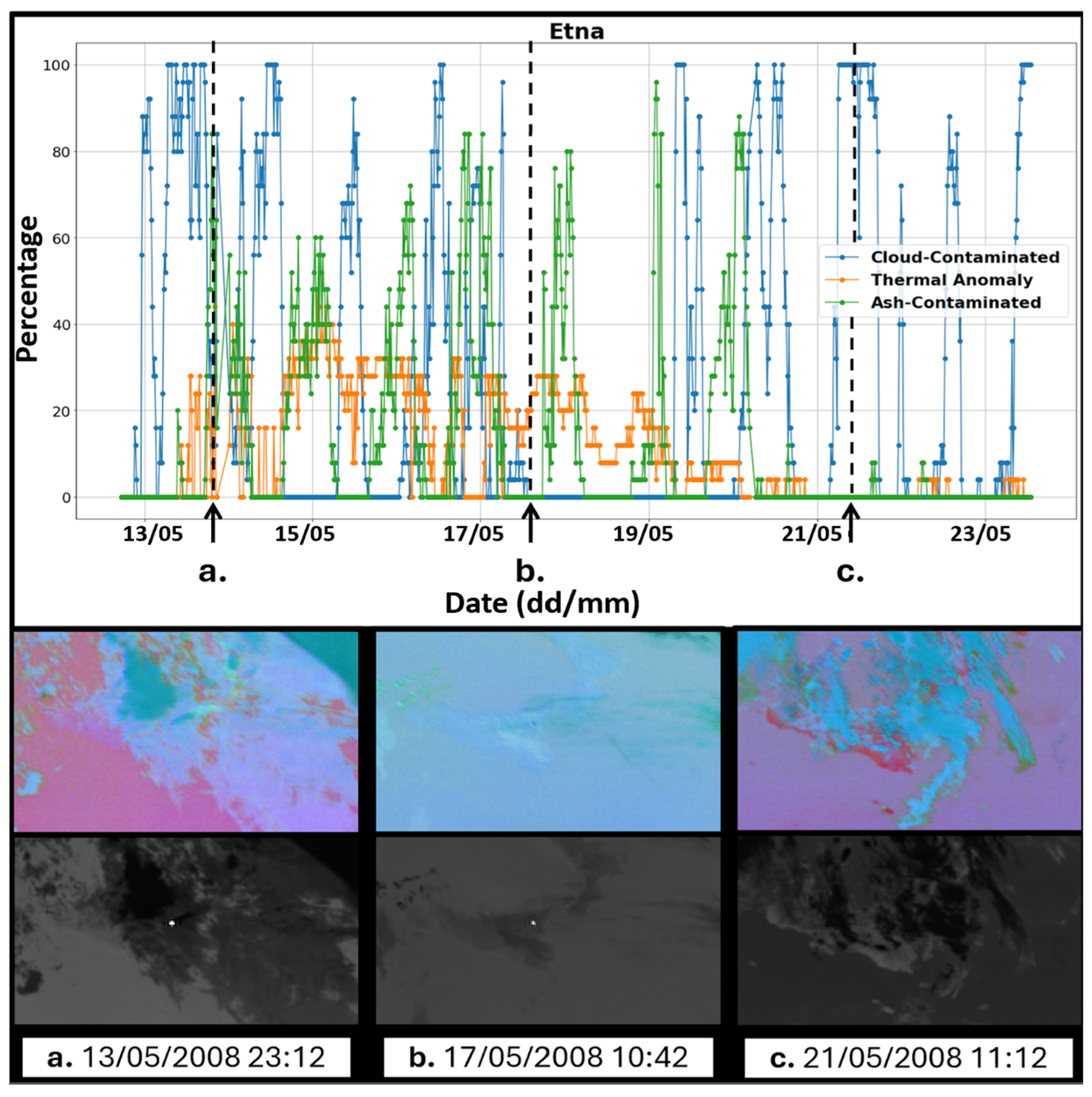

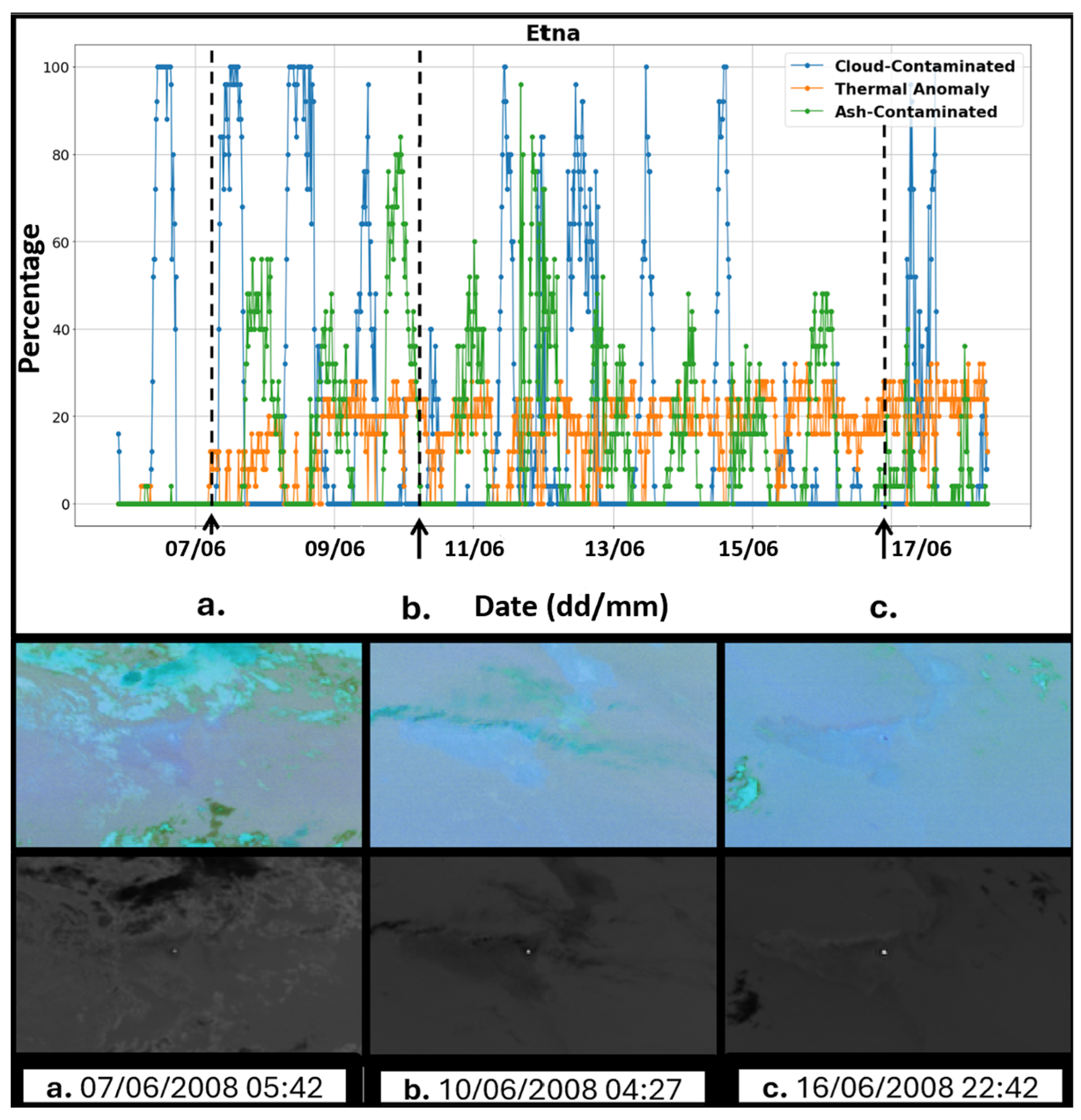
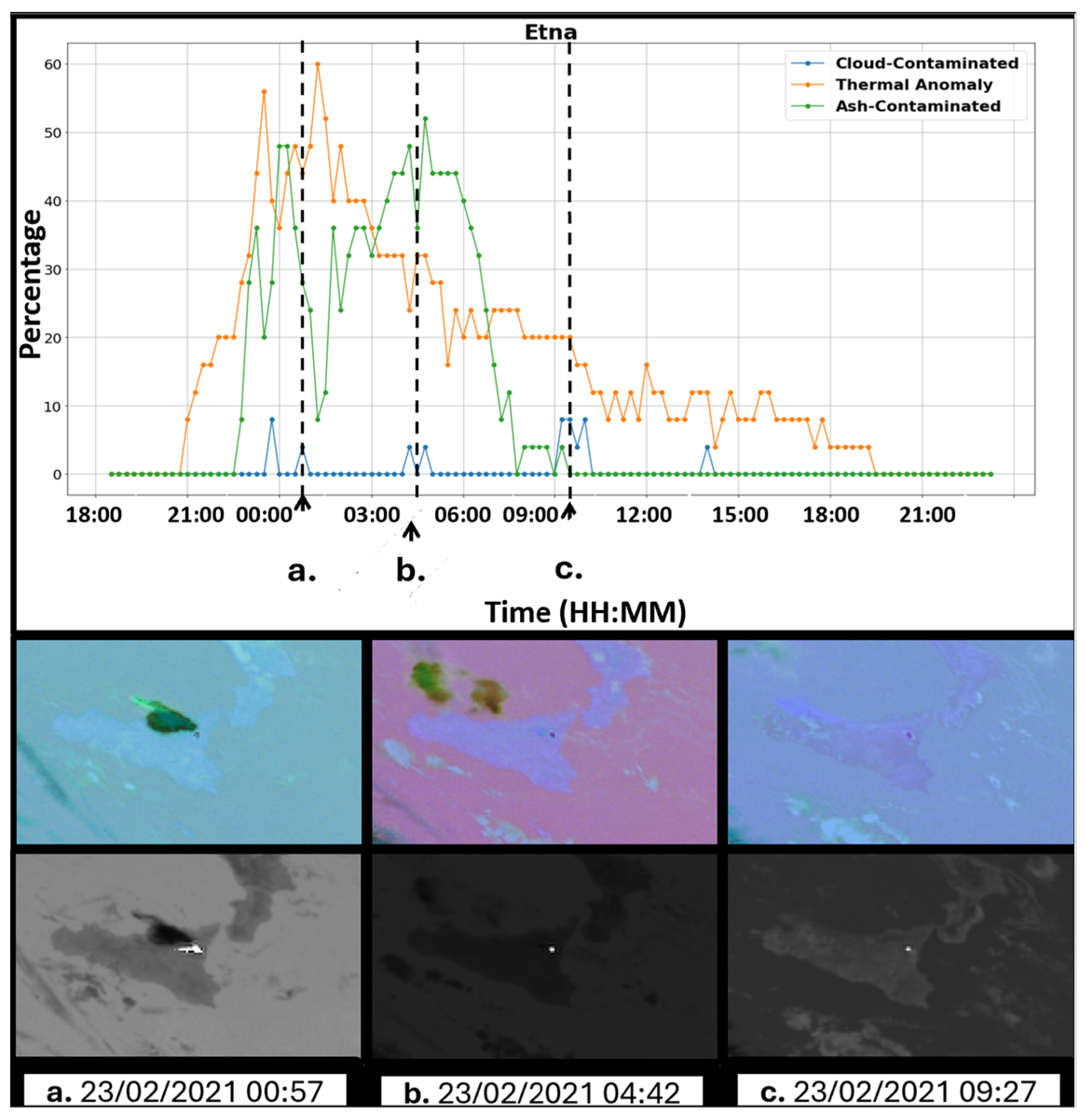
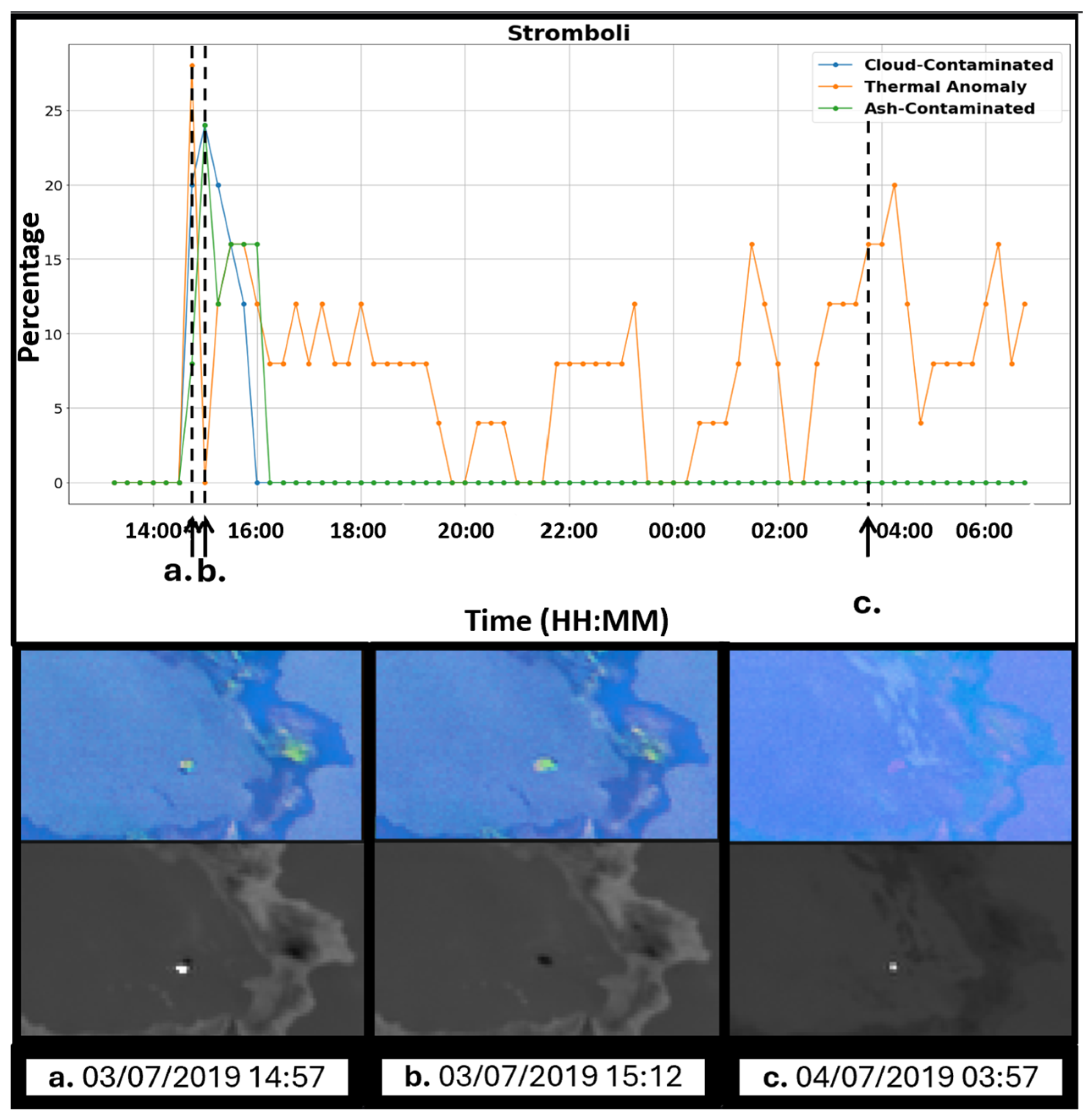
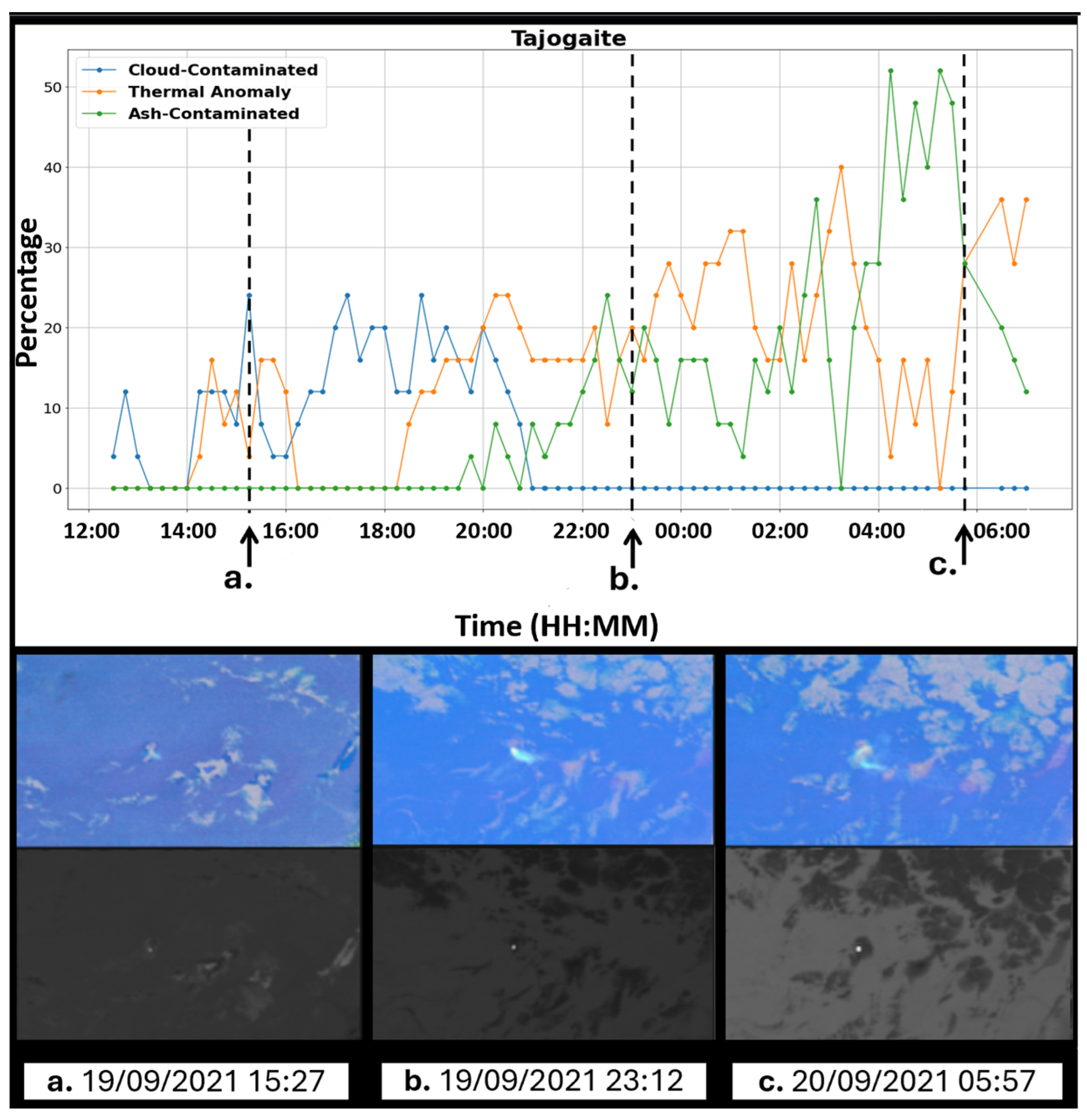
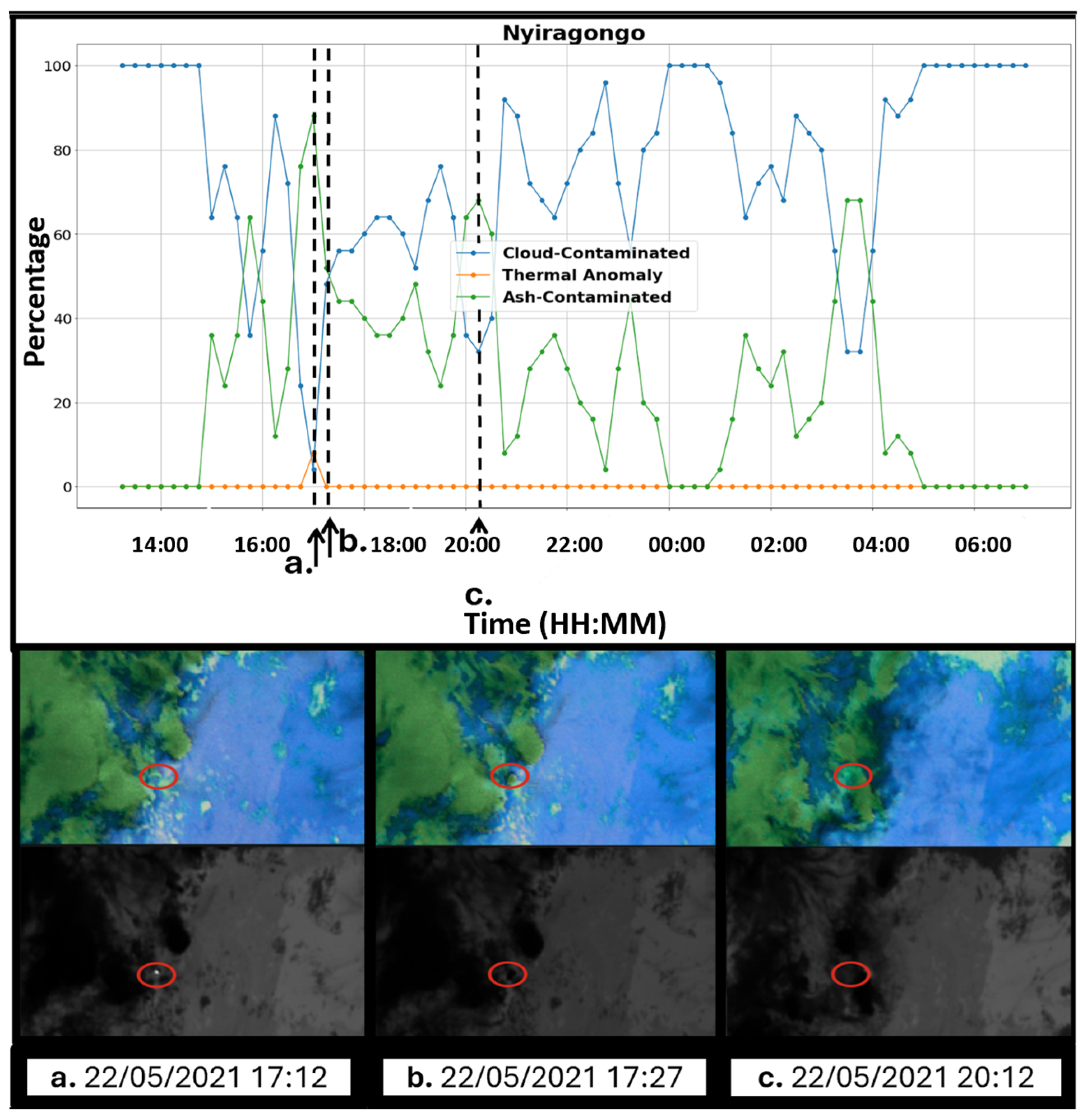
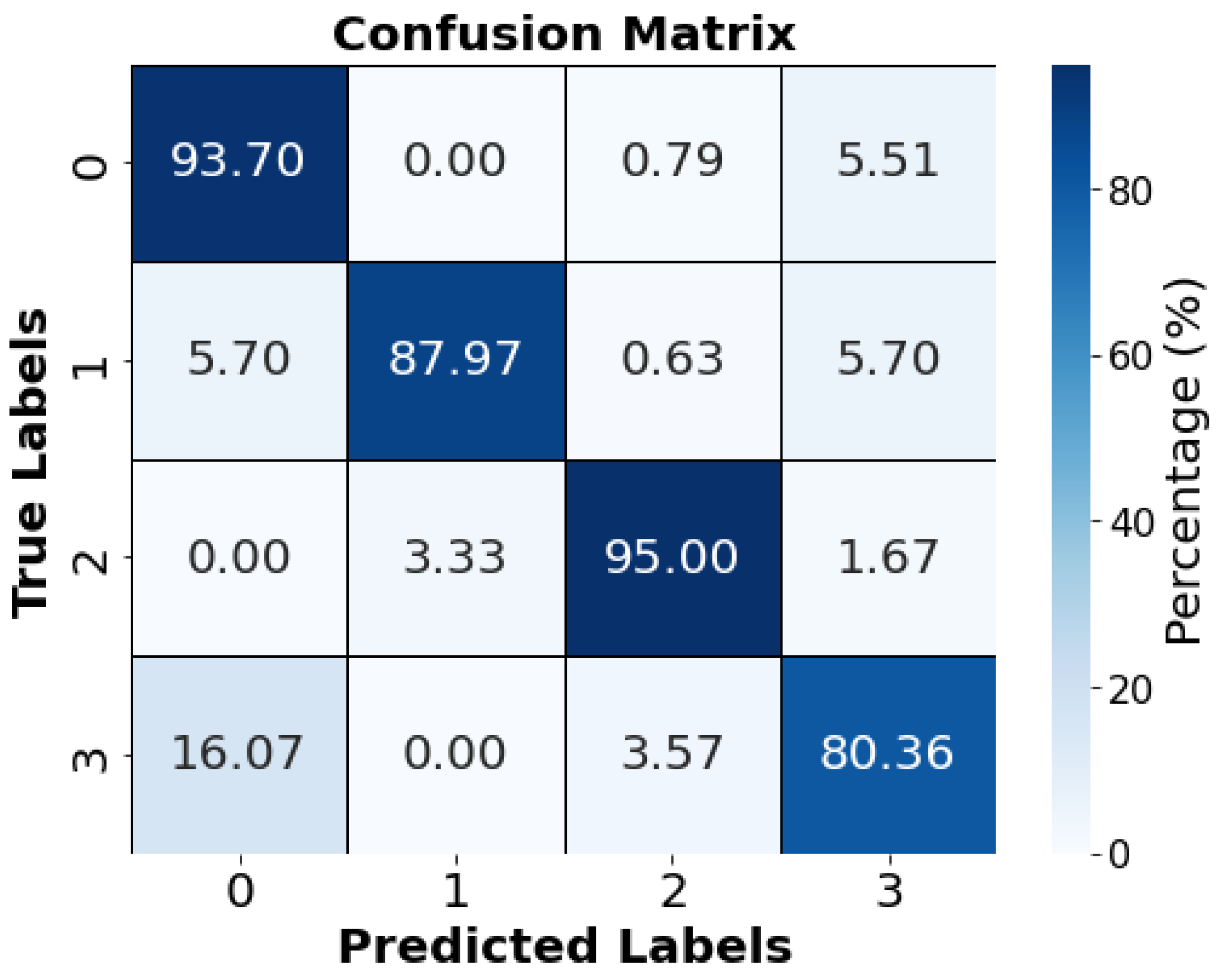
| Channels | Characteristics of Spectral Band (μm) | |||
|---|---|---|---|---|
| λcen | λmin | λmax | ||
| 1 | VIS0.6 | 0.635 | 0.56 | 0.71 |
| 2 | VIS0.8 | 0.81 | 0.74 | 0.88 |
| 3 | NIR1.6 | 1.64 | 1.50 | 1.78 |
| 4 | IR3.9 | 3.90 | 3.48 | 4.56 |
| 5 | WV6.2 | 6.25 | 5.35 | 7.15 |
| 6 | WV7.3 | 7.35 | 6.85 | 7.85 |
| 7 | IR8.7 | 8.70 | 8.30 | 9.10 |
| 8 | IR9.7 | 9.66 | 9.38 | 9.94 |
| 9 | IR10.8 | 10.80 | 9.80 | 11.80 |
| 10 | IR12.0 | 12.00 | 11.00 | 13.00 |
| 11 | IR13.4 | 13.40 | 12.40 | 14.40 |
| Metrics | Value |
|---|---|
| Macro Precision | 0.89 |
| Macro Recall | 0.91 |
| Macro F1-Score | 0.89 |
Disclaimer/Publisher’s Note: The statements, opinions and data contained in all publications are solely those of the individual author(s) and contributor(s) and not of MDPI and/or the editor(s). MDPI and/or the editor(s) disclaim responsibility for any injury to people or property resulting from any ideas, methods, instructions or products referred to in the content. |
© 2025 by the authors. Licensee MDPI, Basel, Switzerland. This article is an open access article distributed under the terms and conditions of the Creative Commons Attribution (CC BY) license (https://creativecommons.org/licenses/by/4.0/).
Share and Cite
Spina, F.; Bilotta, G.; Cappello, A.; Spina, M.; Zuccarello, F.; Ganci, G. Volcanic Activity Classification Through Semi-Supervised Learning Applied to Satellite Radiance Time Series. Remote Sens. 2025, 17, 1679. https://doi.org/10.3390/rs17101679
Spina F, Bilotta G, Cappello A, Spina M, Zuccarello F, Ganci G. Volcanic Activity Classification Through Semi-Supervised Learning Applied to Satellite Radiance Time Series. Remote Sensing. 2025; 17(10):1679. https://doi.org/10.3390/rs17101679
Chicago/Turabian StyleSpina, Francesco, Giuseppe Bilotta, Annalisa Cappello, Marco Spina, Francesco Zuccarello, and Gaetana Ganci. 2025. "Volcanic Activity Classification Through Semi-Supervised Learning Applied to Satellite Radiance Time Series" Remote Sensing 17, no. 10: 1679. https://doi.org/10.3390/rs17101679
APA StyleSpina, F., Bilotta, G., Cappello, A., Spina, M., Zuccarello, F., & Ganci, G. (2025). Volcanic Activity Classification Through Semi-Supervised Learning Applied to Satellite Radiance Time Series. Remote Sensing, 17(10), 1679. https://doi.org/10.3390/rs17101679









